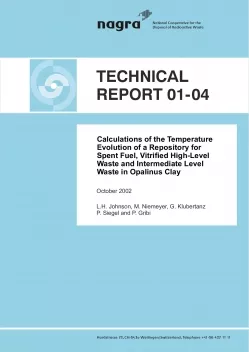
Technical Report NTB 01-04
Calculations of the Temperature Evolution of a Repository for Spent Fuel, Vitrified High-Level Waste and Intermediate Level Waste in Opalinus Clay
Thermal evolution is an important aspect of the performance of a repository for nuclear waste, because elevated temperatures affect many processes influencing the behaviour of engineered barrier systems and the host rock. The thermal evolution of a repository for spent fuel, high-level waste (HLW) and intermediate level waste (ILW) has been evaluated. The repository is assumed to be located at a depth of 650 m in the Opalinus Clay formation in northern Switzerland. The disposal system consists of spent fuel and HLW, encapsulated within steel canisters that are emplaced within horizontal tunnels, with the space between the canisters and the surrounding rock backfilled with bentonite. Waste emplacement tunnels are spaced 40 m apart. Concrete containers of ILW are placed in separate emplacement tunnels, with the void space around the containers filled with cementitious mortar.
The initial heat output of the waste and the rate of its decrease with time due to radioactive decay depends on the nature of the waste. For the case of spent fuel, some canisters contain only UO2 assemblies, while others contain both UO2 and MOX (mixed oxide) fuel assemblies. The initial heat output of both canister types is restricted to 1500 W/canister, but the time-dependent heat output of the UO2/MOX canisters declines more slowly, as a result of significantly higher Pu content. For HLW canisters, the initial heat output is ~700 W and it decreases more rapidly than is the case for spent fuel, because of the low actinide content of HLW.
The temperature evolution of the engineered barrier system and surrounding rock is simulated using a finite-element model, using reference data for the thermal properties of spent fuel, HLW, bentonite backfill and Opalinus Clay. The results show that the surface temperatures of both the HLW and spent fuel canisters reach a maximum value of ~150°C within a few years after emplacement, although the HLW canister temperature decreases much more rapidly than for the case of spent fuel canisters. The temperatures within the bentonite depend strongly on the assumptions regarding its water content. For the expected low water inflow rates in a repository in low permeability Opalinus Clay, the bentonite has a low thermal conductivity and the temperature at the point midway between spent fuel canisters and the bentonite/host rock interface will reach a maximum of ~110°C. For HLW canisters, the mid-point of the bentonite will not exceed 100°C. Host rock temperatures remain below ~90°C at all times. In the unlikely event of a more rapid rate of inflow of water from the Opalinus Clay, the bentonite thermal conductivity is significantly greater and temperatures at the canister/bentonite interface and throughout the bentonite are markedly reduced.
For the case of ILW tunnels, a boundary element model is used to calculate temperature evolution, taking into consideration the hydration heat of the concrete mortar and radioactive decay. It is found that the maximum temperature reached within the engineered barrier system is ~50°C, about 12°C more than the ambient temperature in the Opalinus Clay at a depth of 650 m.
